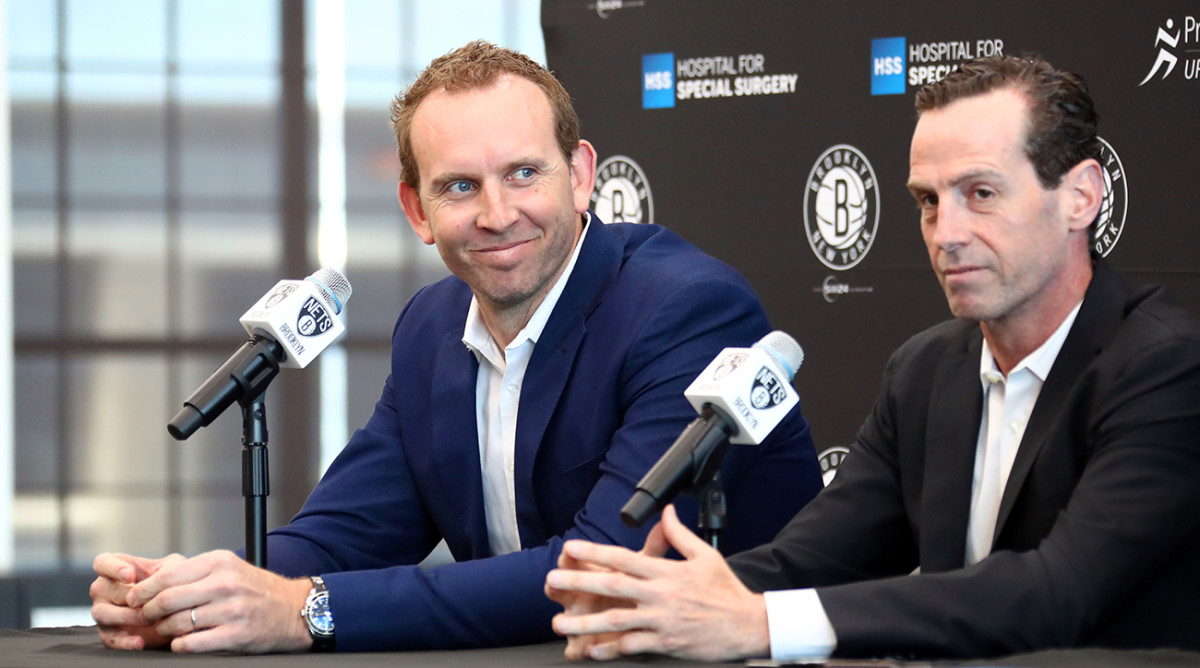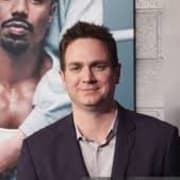Behind the Scenes of the Nets’ Kevin Durant and Kyrie Irving Heist

Sean Marks has a swanky office, neatly tucked into a corner of the eighth floor of the Nets practice facility, a soaring waterfront warehouse in Brooklyn’s Sunset Park neighborhood. Marks, the Nets’ affable, 43-year-old GM, a Kiwi journeyman who squeezed 11 NBA seasons and one title out of his playing career before retiring to front office gigs, just doesn’t like it much. Too isolated. Doesn’t encourage collaboration. Most days, he’s down the hall in the war room, a sparsely decorated, glass-enclosed space in the middle of the facility. There, analytics staffers banter with scouts. Coaches pop in. It’s an open gym, for suits. If you have an idea for improving the team, Marks wants to hear it.
On the afternoon of June 30, Marks and his staff gathered in the war room for the opening hours of free agency. Internally, there was confidence that the team was positioned to land two of the biggest names on the market: Kevin Durant and Kyrie Irving. “Nervous anticipation,” says Marks. Just before 5 pm came the first reports: Both planned to sign with the Nets. It wasn’t until an Instagram post an hour later confirmed Durant’s intentions that Marks fully believed KD was coming. “That sent a shock wave through everyone,” Marks says. Later that evening, Irving made his scheduled visit. Gazing out a window at the city, he spread his arms, savoring the moment. He talked about how long he had been waiting for this. He talked about coming home.The next day it was official: He was in, too.
In February 2016, the Nets hired Marks, an assistant GM in San Antonio, to oversee one of the NBA’s most forbidding rebuilding tasks. The 2013 trade with Boston that brought Kevin Garnett and Paul Pierce to Brooklyn, which yielded a single postseason series win, had backfired spectacularly. The Nets were about to bottom out, winning 20 games in Marks’s first full season—and they didn’t even have a lottery pick to show for it, since the Celtics controlled their first-round picks through 2018. They were a basketball wasteland, desperate to chip away at the Knicks’ supersized fan base, pleading with free agents to see them as a viable New York alternative. Today, the Nets have the two players the Knicks fawned over and unquestioned status as the No. 1 team in the city. In the spring of 2021, with Durant back from the ruptured Achilles that will sideline him next season, the Nets could be competing for a championship.

Let’s stipulate: For the Nets to pull off this offseason heist, location mattered. For months, Durant had been linked with the Knicks. A successful, three-year partnership with Golden State that yielded three Finals trips and two titles was winding down, and there was belief around the league that Durant wanted something different. The Knicks could offer the 30-year-old an opportunity to be the face of—all boils aside—one of the NBA’s flagship franchises. Being in New York gave Durant the chance to take more of a hands-on role with Thirty Five Ventures, the Manhattan-based business and entertainment enterprise Durant cofounded with his manager, Rich Kleiman. Irving, raised on New Jersey blacktops and coming off a chaotic two-season run in Boston, was keenly interested in playing closer to his roots.
Marks now admits that it had long been his hope that the Nets would be positioned to be players in one of the most ravenously anticipated free-agent classes in NBA history. “We planned a couple years out that we could have an opportunity here,” he says. “I think when you have a window or you have an opportunity to swing for it and take a chance, take a challenge, and you can do it with the right people, that’s when you have to do it.”
He understood the undeniable appeal of the City, but the organization had to have some allure as well. Tanking was off the table—and not just because the Nets didn’t own their first-round picks. In 2017, Marks made a deal with the Lakers and absorbed center Timofey Mozgov’s cumbersome contract to acquire guard D’Angelo Russell, an immature former No. 2 pick who would become the Nets’ first All-Star since 2014. (Russell was part of last week’s sign-and-trade that brought Durant to Brooklyn.) He also took on forward Andrew Nicholson’s deal with the Wizards in exchange for the first-round pick that became Jarrett Allen, the team’s springy center.
Player development became a priority. In April 2016, Marks hired Kenny Atkinson, a Hawks assistant with an earned reputation as one of the NBA’s top developmental coaches. Marks invested in the analytics department. He fleshed out the sports-performance team, thinking outside the box: Zach Weatherford, the director of player performance, came from U.S. Naval Special Warfare Command, where he trained SEALs; Dan Meehan, the team’s strength-and-conditioning coach, held the same title with an Australian rules football team in Melbourne.
“It was the most thorough training staff I’ve ever been a part of,” says Jared Dudley, who spent last season with the Nets, his sixth NBA team. Every muscle is tested regularly. Catapult, a GPS technology used to track player movements, helps with load management. “They had so many different ideas,” says DeMarre Carroll, a seven-team vet who played the past two seasons in Brooklyn. “Sometimes in the NBA you get caught up with the traditional stuff.”
Culture took on new importance. In two seasons as a player in San Antonio, Marks was a fringe contributor. But he was treated as well as Tim Duncan. The Spurs’ family atmosphere resonated with Marks. How they treated his wife, Jennifer. How they treated his kids. He was determined to bring that to Brooklyn. So the wives of incoming players now receive flowers. Kids get boxes of Nets gear. After Dudley signed with the Lakers last week, his wife received a card, thanking her for being part of the organization. Says Dudley, “The way they treated my family—no organization has come close.”
Still, results matter, and that feel-good vibe was threatened last fall, during an eight-game losing streak. Reports about Atkinson’s job security filtered into the locker room. Guard Caris LeVert, a blooming star, was lost until midseason with an ankle injury. Players wondered: With the Nets finally in control of their draft pick, would they tank the season away? Atkinson called three of the team’s veterans—Dudley, Carroll and Ed Davis—into a meeting. His message to them: Ownership called. There would be no tanking. Their message to him: Don’t sacrifice wins for the sake of development. Play the best players. Atkinson agreed. A players-only film session followed. Laziness was called out. Sloppiness. Bad body language. Frustrations were aired. “That film session,” says Dudley, “was the best thing for us.” They followed up the meeting with seven straight wins and surged into the playoffs as the No. 6 seed.
Eight weeks later, Brooklyn shipped Allen Crabbe to Atlanta, freeing up double-max cap space. The pieces were finally in place, the message finally ready to go out: If you’re an elite free agent, come to Brooklyn. And bring a friend.
For months, Irving and Durant had been the dream. The Nets were well aware of Irving’s discontent in Boston. Irving famously told fans before last season that he was going to re-sign this summer. But the combination of the team’s underachieving and his chilly relationship with teammates and coaches made Irving reconsider by midseason. Brooklyn point guard Spencer Dinwiddie, a close friend of Irving’s, was in close contact. “Everyone knew Spencer was talking to him,” a source with direct knowledge of the Nets told SI. “The coaching staff knew it. The front office knew it. It wasn’t like they were asking him all the time, ‘What’s going on?’ But they knew his relationship with Kyrie.” When the season ended, the Nets immediately emerged as Irving’s preferred home, two sources familiar with Irving’s thinking told SI.
Durant’s decision took longer. The Knicks were in play, though never to the all-but-done-deal extent that had been reported. So, too, were the Warriors, who could offer a five-year, $221 million contract—one year and $57 million more than Brooklyn could pay. What Durant wanted was simple. A good team. A strong, supportive environment. The Nets checked all the boxes. Durant’s decision was never directly tied to Irving’s, but the opportunity to play with his close friend certainly appealed to him.
For Brooklyn, Durant’s injury needed to be considered. An Achilles tear is among the most significant injuries for an NBA player. Marks told his medical team: Dig into it. They watched video of the injury. They studied the media reports. With Durant still under contract with Golden State, the Nets, Marks says, “did not have all the facts.” Any deal they offered would basically mean taking Durant, who will be 32 when he next steps onto the court, in as-is condition. Days before free agency, Marks gathered the medical staff. He asked for a show of hands: Who was in favor of committing a max contract? Every hand shot up.
“That was a pretty moving moment,” says Marks. “When you know there’s a group of young men and women that are here saying, ‘Hell, we can’t wait for that challenge. We cannot wait to sacrifice whatever it takes to get [Durant] out on the court again, and probably prove people wrong.’ Again, it’s that sort of chip on your shoulder. Kenny and I talk about it a lot, players having that. But I think it’s also important that your entire organization has something to prove.”
In 2013 a big-market franchise made a blockbuster trade. Two All-Stars were added to a playoff team. Expectations soared. Sports Illustrated put the five starters, along with their coach, on the cover. The headline: who wants a piece of them? The team was the Nets. The answer, it turned out, was everyone.
It’s easy to look good on paper. The risk in the signings extend beyond Durant’s health. What is the tone Irving will set in the locker room even before Durant enters it? The Nets—for next year, anyway—are effectively Boston Lite, a solid young team with a coach who sees the regular season as a chance to grow and improve. Irving sees the regular season as a six-month obligation to be suffered before the playoffs. Atkinson is more combative than Celtics coach Brad Stevens. “I can see them going at it,” says Dudley. “[Atkinson] holds everyone accountable. But he’s a players’ coach. He’ll go at you, but he’ll bring you into a meeting, watch film with you, and ask you what he can do to make you better.”
To Marks, the risk is worth the potential reward. “Whenever you can add this type of talent, you probably should jump at the chance to do it,” says Marks. “Especially guys that want to be here. Especially them.” Indeed, the Nets have come a long way. Once the team across the river, they have invaded the Knicks’ backyard. Once a nonthreatening neighbor, the Nets have become the preferred New York destination. A new beginning for Durant, for Irving. And for Brooklyn.
